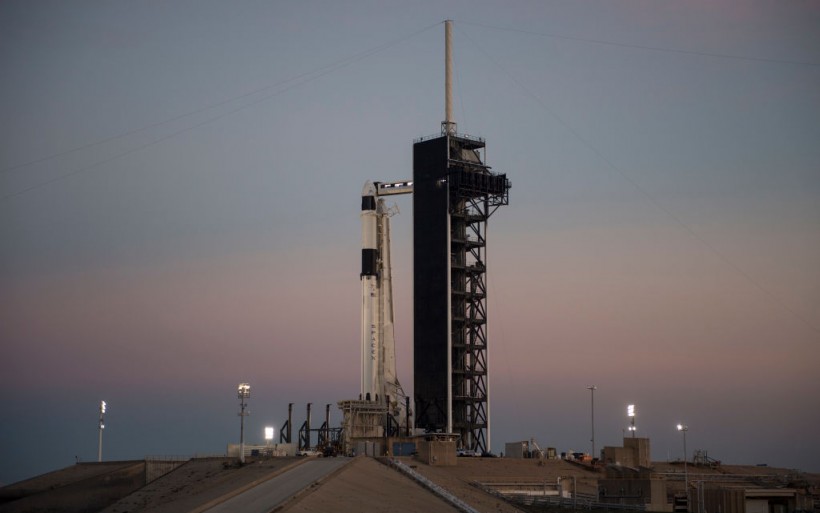Due to adverse weather, SpaceX delayed its third attempt to launch the Italian satellite on Friday. It was postponed for Sunday at 6:11 p.m. EST. A livestream will be available on several networks.
The current weather conditions are causing major challenges for SpaceX, an aerospace corporation. Due to heavy clouds and strong upper-level winds, it aborted its Falcon 9 flight. Other scheduled flights have been delayed as a result of the delay.

CAPE CANAVERAL, FL - FEBRUARY 28: A SpaceX Falcon 9 rocket with the company's Crew Dragon spacecraft onboard is seen after being raised into a vertical position on the launch pad at Launch Complex 39A as preparations continue for the Demo-1 mission, February 28 2019 at the Kennedy Space Center in Florida. The Demo-1 mission will be the first launch of a commercially built and operated American spacecraft and space system designed for humans as part of NASA's Commercial Crew Program. The mission, currently targeted for a 2:49am launch on March 2, will serve as an end-to-end test of the system's capabilities.
SpaceX Delays Italian Satellite Launch For The Third Time
Due to severe weather, SpaceX is now set to launch an Italian Earth-observation satellite no early than Sunday, two days later than intended, and you can watch it launch live here.
"Due to weather in Florida affecting pre-launch operations, now targeting Sunday, January 30 at 6:11 p.m. EST for launch of COSMO-SkyMed Second Generation FM2 from SLC-40," the aerospace company tweeted.
Due to weather in Florida affecting pre-launch operations, now targeting Sunday, January 30 at 6:11 p.m. EST for launch of COSMO-SkyMed Second Generation FM2 from SLC-40
— SpaceX (@SpaceX) January 29, 2022
According to US Space Force's Delta 45 group, there is a more than 90 percent possibility of excellent launch conditions on Sunday, with heavy clouds being the main concern.
Space.com said the first stage of the Falcon 9 rocket will be launched for the third time. For the US military, the rocket previously assisted in launching the Arabsat-6A communications satellite and the Space Test Program 2 mission. The rocket is planned to return for a vertical landing at SpaceX's Landing Site 1 at Cape Canaveral not long after launch for this trip.
What to Expect From Launch
Digital Trends said SpaceX will launch an Earth observation satellite into orbit using a Falcon 9 rocket from Cape Canaveral Space Force Station's Complex 40. The mission will launch a COSMO-SkyMed Second Generation 2 satellite for the Italian Space Agency, which will be added to the COSMO-SkyMed satellite network.
ALSO READ: SpaceX Wants to Launch Rockets Weekly to Achieve Elon Musk's Goal of Having 52 Missions in 2022
So far, the launch has been postponed three times. It was initially set on Thursday, Jan. 27, but was rescheduled for yesterday, Jan. 28. The launch has been postponed till Sunday. It had been delayed each occasion due to weather conditions at the launch site.
Another SpaceX launch is also scheduled for this weekend. To accommodate this change in schedule, SpaceX said the launch of Starlink was also postponed. Fox35 said SpaceX has also stated that a launch from California is planned on Wednesday, Feb. 2.
About This Italian Satellite
The Italian Earth-observation satellite COSMO-SkyMed Second Generation 2, for example, is the major package SpaceX is launching.
The additional satellites will complete functional continuity of the whole COSMO-SkyMed constellation, which has been in orbit for more than 15 years, according to Telespazio, the Italian space services business behind this project, as reported by UPI.
The satellite can also take high-resolution pictures of the Earth's surface. This may be used to map topographical characteristics, give defense and security information, find resources, track ships, and monitor catastrophes, forests, and agriculture, among other things.
How to Watch Launch
The launch will be broadcast live on SpaceX's website, so you can watch it from the comfort of your own home. Final launch preparations, liftoff, ascension, and first stage separation, second stage ignition, fairing deployment, and payload separation will all be covered in the webcast. It will also display the initial stage's entering burn and catching.
Coverage begins 15 minutes before the start of the event. You may watch the webcast by going to SpaceX's YouTube channel or by watching the video posted below.
RELATED ARTICLE: SpaceX to Reuse Dragon Spacecraft Fleet After Rocket Booster from NASA Crew-1 'Leaned'
Check out more news and information on SpaceX in Science Times.














